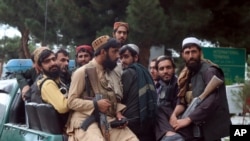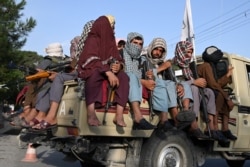Buoyed by the West’s withdrawal from Afghanistan, Taliban commanders say they are confident they can defeat the Islamic State terror affiliate, which claimed responsibility for last month’s suicide bombing at Kabul airport, killing more than a dozen U.S. military personnel and at least 170 Afghans.
Pausing between a string of firefights between the Taliban and the Islamic State-Khorasan Province group last week in west Kabul, a Taliban commander boasted to Western reporters that Afghanistan’s new rulers will finish off their rivals much as they forced NATO to withdraw from the country.
Some analysts predict the fight between the Taliban and IS-Khorasan – also known as ISIS-K – will pitch a pair of ruthless and battle-hardened groups of militants in a jihadi fratricide which will likely see no mercy given.
Even before U.S. forces withdrew this week, the Taliban executed some senior IS-Khorasan commanders imprisoned by the Afghan government of Ashraf Ghani, including shooting dead its former top leader Mawlawi Ziya ul-Haq.
The executions were first reported by The Wall Street Journal.
Khorasan was a sixth-century Islamic region spanning parts of modern-day Afghanistan and Pakistan as well as parts of Central Asia.
Complicating factor
IS-Khorasan has the potential to cause Afghanistan’s new rulers plenty to worry about, complicating their efforts to consolidate power and establish a national government, in the view of Western military officials and independent counter-terrorism analysts. “The Taliban faces its own threat from ISIS-K,” argues Anthony Cordesman in a commentary Tuesday for the Center for Strategic and International Studies, a Washington research institution.
His CSIS colleague Seth Jones, a former adviser to the commanding general of U.S. Special Operations Forces in Afghanistan, says IS-Khorasan now has “a lot of opportunity for resurgence.” He notes the affiliate’s fortunes had been declining recently thanks to the U.S. and Afghan forces conducting “pretty persistent strikes” on the group. He estimates their numbers had fallen from around 6,000 to 2,000.
IS-Khorasan first appeared in Afghanistan in late 2014, comprising Pakistani militants who crossed into Afghanistan to escape a Pakistani army offensive. The group has carried out dozens of deadly attacks and suicide bombings over the past few years and been blamed for some of the worst recent atrocities, involving girls’ schools, hospitals and a maternity ward, where their fighters reportedly shot dead pregnant women and slaughtered nurses.
The Kabul airport blast last week underlined its capacity for violence.
The group’s founder, Abdul Rauf Aliza, was a provincial-level Taliban commander before falling out with the Taliban leadership in 2014. He was killed in a U.S. drone strike in February 2015. IS-Khorasan’s current leader, Shahab al-Muhajir, is also a former mid-level Taliban commander, who also worked for al-Qaida and is suspected by some Western security officials of still enjoying close ties with the leaders of the Haqqani network, a major Taliban faction currently in charge of security in the Afghan capital.
Those suspected ties prompted Michael Pregent, a former U.S. intelligence officer and now an analyst at the Hudson Institute, a U.S.-based research group, to suggest last week that elements of the Taliban likely colluded in the Kabul airport bombing. “If it was ISIS-K, they passed through Haqqani security, because they have command and control of Kabul, and they have an intelligence apparatus.” He added the bomber also managed to navigate “multiple Taliban checkpoints in order to hit Americans.”
Whether a full-fledged affiliate of ISIS or not, Shahab al-Muhajir is seen as being highly ambitious and the core leadership seems eager now to expand to Afghanistan. Jihadist chat rooms — pro-Islamic State ones as well as al-Qaida-dominated forums — are full of discussions about how the focus should now switch from Syria to Afghanistan.
A U.N. report last year reported that al-Muhajir was seeking to swell IS-Khorasan’s ranks with disaffected Taliban fighters and other militants. He is likely to take advantage of any missteps by the Taliban and local disputes among Taliban commanders.
If Taliban leaders are serious about moderating their imposition of Sharia and to be less oppressive than when they ruled in the 1990s — as their top leaders have suggested publicly — then they run the risk of defections to IS-Khorasan, suspect some NGO workers.
The chief of party of a European NGO told VOA this week that she has noticed clear geographical differences across the country when it comes to how the Taliban is ruling.
“In the South, we have not yet received approval for male and females to work. They have told us our men can resume work, but not our females,” she said. She asked not to be named in this article and for her NGO to remain unidentified.
With the country facing catastrophic food shortages, mass unemployment, and collapsing health and education systems, according to U.N. officials, IS-Khorasan will have plenty of disaffection to exploit.
Some Western security officials also say Afghanistan, with its mixture of ethnic minorities, around 14 in all, is a natural location for Islamic State, which has been adept in Syria and Iraq at exploiting sectarian divides. Many of IS-Khorasan attacks have targeted Afghanistan’s Shi’ite Hazara minority, they note.











